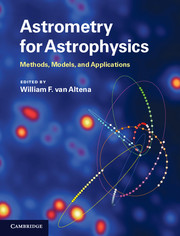Book contents
- Frontmatter
- Contents
- List of contributors
- List of acronyms
- Preface
- Part I Astrometry in the twenty-first century
- Part II Foundations of astrometry and celestial mechanics
- Part III Observing through the atmosphere
- Part IV From detected photons to the celestial sphere
- Part V Applications of astrometry to topics in astrophysics
- Index
Preface
Published online by Cambridge University Press: 05 December 2012
- Frontmatter
- Contents
- List of contributors
- List of acronyms
- Preface
- Part I Astrometry in the twenty-first century
- Part II Foundations of astrometry and celestial mechanics
- Part III Observing through the atmosphere
- Part IV From detected photons to the celestial sphere
- Part V Applications of astrometry to topics in astrophysics
- Index
Summary
Why do we need another text on astrometry?
Astrometry entered a new era with the advent of microarcsecond positions, parallaxes, and proper motions. Cutting-edge topics in science are now being addressed that were far beyond our grasp only a few years ago. It will soon be possible to determine definitive distances to Cepheid variables, the center of our Galaxy, the Magellanic Clouds and other Local Group members. We will measure the orbital parameters of dwarf galaxies and stellar streams that are merging with the Milky Way, define the kinematics, dynamics, and structure of our Galaxy and search for evidence of the dark matter that constitutes most of the Universe's mass. Stellar masses will be determined routinely to 1% accuracy and we will be able to make full orbit solutions and mass determinations for extrasolar planetary systems. If we are to take advantage of microarcsecond astrometry, we need to reformulate our study of reference frames, systems, and the equations of motion in the context of special and general relativity. Methods need to be developed to statistically analyze our data and calibrate our instruments to levels beyond current standards. As a consequence, our curricula must be drastically revised to meet the needs of students in the twenty-first century.
In October 2007, IAU Symposium 248 “A Giant Step: From Milli- to Micro-arcsecond Astrometry” was held in Shanghai, China. Approximately 200 astronomers attended and presented an array of outstanding talks. I was asked to present a talk on the educational needs of students who might wish to study astrometry in the era of microarcsecond astrometry and to organize a round-table discussion on the topic. In the process of preparing my talk and organizing the session, I realized that I had a unique opportunity to bring together the experts on virtually all topics that might be covered in an introductory text on astrometry. This book is the result of the advice from many individuals in the worldwide astrometric community, most of whom were present at that Shanghai meeting and in particular the 28 authors who wrote the 28 chapters.
- Type
- Chapter
- Information
- Astrometry for AstrophysicsMethods, Models, and Applications, pp. xvii - xviiiPublisher: Cambridge University PressPrint publication year: 2012

